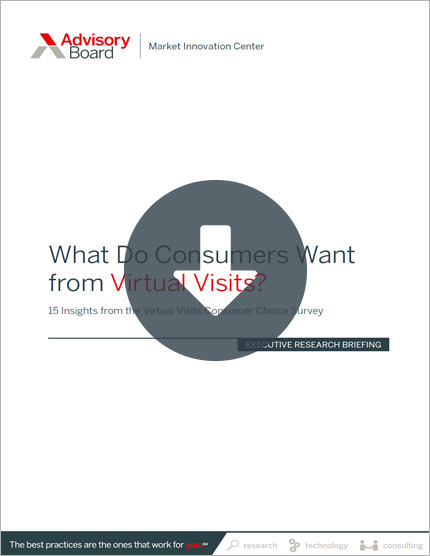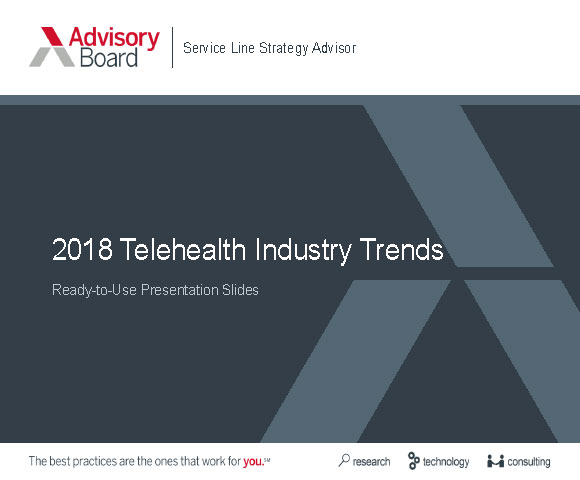Auto logout in seconds.
Continue LogoutBy Anna Yakovenko, Practice Manager, and Emily Heuser, Consultant
Even though hospitals and health systems are making big investments in telehealth infrastructure, some providers are skeptical that patients would be willing to use telehealth services over an in-person visit. However, an Advisory Board survey of nearly 5,000 consumers revealed that this skepticism may be unfounded: 77% of respondents indicated that they'd consider seeing a practitioner virtually—and 19% already had done so.
To win consumers in this growing market, you first need to understand what they want from virtual visits in different scenarios. Join us for a webconference on Wednesday, April 18 to learn about the latest telehealth market trends and find out how patient preferences are shaping the future virtual care landscape.
Keep reading to learn four characteristics of today's telehealth patients, the factors that are most likely to convince those who haven't yet scheduled a virtual visit to take the plunge, and the opportunities for virtual visits beyond primary care.
What do today's—and tomorrow's—telehealth patients look like?
Nineteen percent of survey respondents reported having at least one virtual visit, and 39% of parents reported having used a virtual visit for their child. So who are these early adopters, and what can you learn from them?
- They're young. More than half—59%—of patients who've already utilized virtual visits are under the age of 50. That's largely due to Medicare's reimbursement restrictions for telehealth services, which suggests that insurance coverage is as much of a factor as the generation gap.
- They live in cities. Much is made of telehealth's potential to provide access in sparsely populated, rural areas, but today's telehealth patients are most likely to live in an urban area. More than 33% of city-dwellers have had a virtual visit, compared with fewer than 9% of those in suburbia, small towns, and rural areas.
- They're high earners. More than 52% of patients who've had at least one virtual visit make more than $71,000 per year. Respondents in this income bracket were also 10 times more likely to use telehealth services for a child.
- They have private insurance. While about 15% of privately insured respondents have used a virtual visit at least once, fewer than 4% of publicly and uninsured have.
To ensure program scalability and sustainability over time, providers must develop multifaceted marketing strategies that improve consumer outreach and encourage adoption of telehealth services.
Read our briefing to learn about the consumer values and preferences that drive adoption, the barriers or concerns that deter consumers from trying virtual care, the most effective communication channels to advertise virtual services, and the platform capabilities that can enhance user experience and boost patient loyalty.
What types of virtual visits do consumer want?
Virtual visits are traditionally associated with primary care, but patients are embracing a variety of other use cases.
Pediatrics provided some of the most striking results: More respondents were interested in using a virtual sick visit for their child than for themselves. More than half of parents—57%--said they would strongly consider using a virtual visit if their child was sick, compared with 44% who would strongly consider seeing a provider virtually for themselves. Overall, Advisory Board experts say telepediatrics offer a significant opportunity to earn parents' trust today and their business—both in-person and virtual—down the road.
There's also significant patient interest in the potential of virtual visits to provide quicker sick care access. Fifty-one percent of consumers said they'd be open to using telehealth services when the wait to see their regular provider in-person was a week or longer.
Finally, 50% consumers indicated interest in using virtual visits for prescription drug refills. In particular, respondents who have had strokes, have osteoporosis or atrial fibrillation, or take three or more medications expressed the most interest in using virtual visits for prescription refills. One provider that has embraced this approach is Stanford Medicine, which partnered with a pharmacy vendor offering same-day delivery—and achieved 60% telehealth adoption.
Next, join us to learn telehealth market trends for 2018
Join our telehealth experts for a webconference on Wednesday, April 18 to hear the latest updates on the current state of the telehealth market, guidance on common planning pitfalls to avoid, and examples of how leading provider organizations are achieving success using virtual care delivery platforms.
Don't miss out on the latest Advisory Board insights
Create your free account to access 1 resource, including the latest research and webinars.
Want access without creating an account?
You have 1 free members-only resource remaining this month.
1 free members-only resources remaining
1 free members-only resources remaining
You've reached your limit of free insights
Become a member to access all of Advisory Board's resources, events, and experts
Never miss out on the latest innovative health care content tailored to you.
Benefits include:
You've reached your limit of free insights
Become a member to access all of Advisory Board's resources, events, and experts
Never miss out on the latest innovative health care content tailored to you.
Benefits include:
This content is available through your Curated Research partnership with Advisory Board. Click on ‘view this resource’ to read the full piece
Email ask@advisory.com to learn more
Click on ‘Become a Member’ to learn about the benefits of a Full-Access partnership with Advisory Board
Never miss out on the latest innovative health care content tailored to you.
Benefits Include:
This is for members only. Learn more.
Click on ‘Become a Member’ to learn about the benefits of a Full-Access partnership with Advisory Board
Never miss out on the latest innovative health care content tailored to you.


